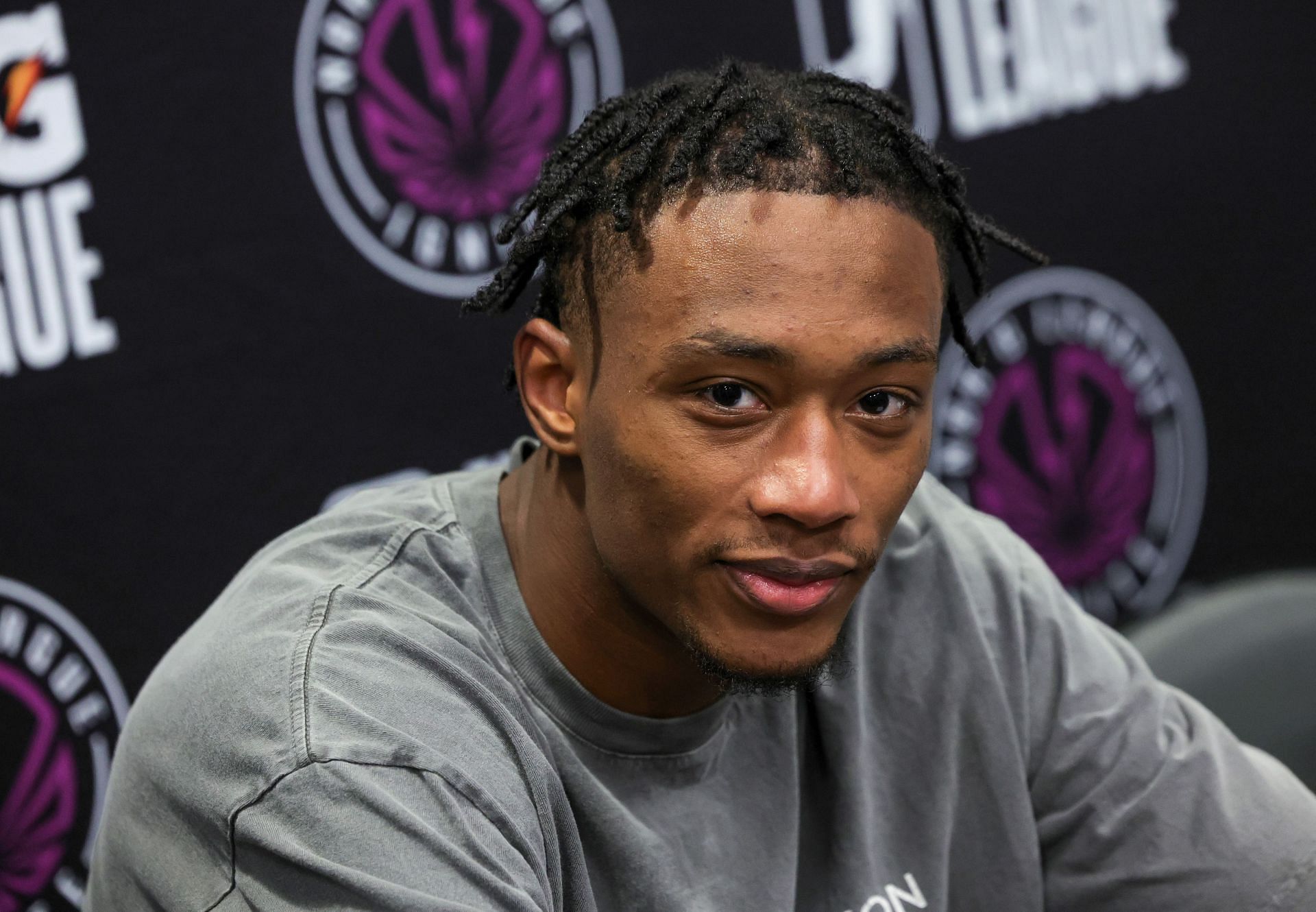
Ron Holland is the biggest steal in the 2024 NBA draft
The 2024 NBA draft class lacks the star upside bets that sit atop most classes. Ron Holland is an outlier here, as one of the few true high-ceiling prospects in the class. Few wings match his blend of athletic tools, advantage creation, ball skills and defensive upside. Why then is a prospect who many view as top three quality rumored to fall out of a weak lottery?
Detractors often cite Holland’s inefficiency; he slashed 19.5-6.7-2.9 with 2.3 steals on a poor 24% from three and 56% true shooting. While it’s true Holland didn’t score efficiently, it’s incredibly common for young initiators to shoot with poor efficiency and Holland produced at a fairly high level playing against pros.
Holland’s elite driving fuels his star offensive upside. Few wings can match his combination of first step, strength and vertical explosion. He wins at all levels, blowing by defenders cleanly for big dunks in the half-court and tossing older defenders aside with his power.
Independent of his physical tools, Holland flashes the handling necessary to string together multiple moves to win off of the dribble. All of this skill congeals into a star-upside driving package, as Holland projects to pressure the paint relentlessly.
Ron Holland scouting report: Why is his he slipping in the lottery?
At the rim, Holland finished a decent 53% of his half-court attempts. That number deflated due to Holland’s absurd creation burden — by my tracking, Holland generated a ludicrous 87.6% of his half-court rim attempts, often driving into crowed paints and help defense. Though his decision-making can improve, Ignite’s poor spacing and offensive organization didn’t help Holland here.
When Holland draws defenses as a slasher, he threatens as a scorer at the rim and a playmaker. Holland shares similar flaws to most high-volume teenage passers — inconsistent accuracy, ball placement and decision-making. Despite his 0.9 assist-to-turnover ratio, Holland flashes NBA-level pick-and-roll reads, wrapping passes to rollers in tight windows and skipping out to the corner.
Like many prospects in this class, Holland’s ceiling will hinge on his shooting. Holland shot 24% from three on 3.6 attempts per game. That number must improve drastically, but young shooters tend to struggle from deep, especially an 18-year-old shooting from a much deeper line. He’s a solid free-throw shooter (75.7%) and his touch mentioned above provides hope for future shooting development.
This is Holland’s first year of high-volume creation. He dominated defenders as a bruising, playmaking four, rarely playing on the outside. Across his last EYBL and high school seasons, Holland shot 10/41 (24.4%) on catch-and-shoot threes (per Synergy), which jumped to 20/75 (26.7%) on the season.
He hasn’t been forced to rely on his jumper in the past, so there might be more to unlock shooting-wise. Holland looks comfortable pulling up in the mid-range, punishing defenses sliding under screens and maneuvering to spots with his handle.
Ron Holland defense: Why his physical gifts might help him reach a higher ceiling?
On the defensive end, Holland’s upside may be even higher as a result of his absurd physical tools. Standing 6’6.5 with a 6’11 wingspan, Holland’s frame allows for wins with brute strength, length and overwhelming movement skill. He’s flashed the capacity to guard almost every position, gliding around the court with elite lateral quickness and fluidity. Against ball screens, Holland’s strength lets him blow through weaker picks and erase actions before they can start.
Holland’s defensive playmaking off of the ball is phenomenal, evidenced by his 3.7% steal rate. He blows up actions with great instincts and athleticism, jumping passing lanes and rotating off of the ball to help out his teammates. When Holland loses off of the dribble or lapses off of the ball, he’s equipped with unique recovery tools to get himself back into position to make a play on the ball and disrupt.
Most of Holland’s defensive issues aren’t due to physical limitations, but rather effort level and technique. He’s over-aggressive at times defending the ball, leaning forward at the point of attack exposing himself to blowbys. Holland understandably loves to trust his recovery tools but NBA offenses will expose the technique on the ball. Off of the ball, Holland will lapse and give up easy shots a bit more than he should.
The context here is critical for projecting Holland’s defense to the NBA. G-League Ignite’s defense was atrocious, marred with constant errors and miscommunications. That’s what happens when you pair a bunch of teenagers and non-defending vets, making everyone on that defense look worse.
Holland carried a monster offensive load, expending tons of energy to score. His defensive attentiveness will rise in a smaller role at the next level. It’s exceedingly common for physically gifted teenagers — Jaylen Brown, Jaden McDaniels, Jalen Suggs — to struggle with focus/attention in college and improve drastically in the pros.
Though his attentiveness wasn’t always perfect, Holland has a long track of playing with borderline psychopathic effort and motor whether it was AAU, all-star circuit or FIBA competition. That’s a great sign for future development, trusting Holland to put himself in a position to succeed.
Many of Holland’s problems boiled down to his high usage, operating as the primary offensive and defensive option at times for a terrible basketball team. Among freshmen-aged prospects, only Isaiah Collier and Rob Dillingham top Holland’s 27.1% usage rate.
Ron Holland isn’t a perfect prospect. There’s a universe where Holland’s shot never develops and his bad habits maintain into the pros. His ceiling, however, is higher than almost any prospect in this class. Elite two-way wings who thrive as advantage creators and versatile defenders bring unquantifiable value, especially in the postseason. If Holland slips out of the top 10 or the lottery, he’s set up to be one of the biggest steals in the 2024 NBA draft.